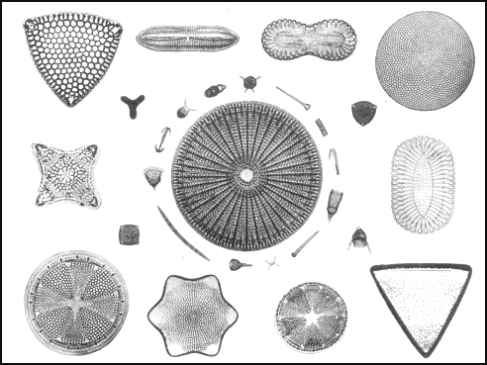
 |
by Jo Hunt 1962 |
|
With the exploration of outer space, we have encontered many new forms of plant life for our
scientists to place under their microscopes. However, right here on earth, there is a tiny plankton plant of the ocean which many of you
young scientists have yet to observe. This is the diatom. The jewel-like skeletons of diatoms, as show in the picture above, are the remains of tiny marine plants that lived and died in the ocean millions of years ago. Diatoms are microscopic, single-celled organisms or flowerless plants. They are invisible as single units, but you can recognize them in colonies as jelly-like growths. Sometime they are free-floating, other times they stick to rocks and larger vegetation. They are characterized by the production of a shell consisting of two parts or valves of silica which enclose the living cell. These shells differ so in size and shape and markings that the shape and beauty of these designs have fascinated scientists since their discovery over three centuries ago. A Dutchman, Anthony Van Leeuwenhock, first observed them through a microscope that he made himself. To date, some 8,000 to 10,000 forms have been classified. They are so tiny it would take 2,000 of them laid end to end to measure one inch. Diatoms are important before they die, too. They are a source of food for other marine life. Amoebae and many other forms of water life, even some small fish, eat diatoms. For this reason, they have been called the "Grass of the Sea." When a diatom dies, it sinks to the bottom and the organic portion decomposes, leaving a rock hard skeleton. Where the water is still, these skeletons remain intact and do not break up as easily as in rushing water. This fossil sediment if elevated above the water at a later period, becomes a deposit of diatomite. These deposits are found throughiout the world. Deposits are mined in California and Oregon and geologists are searching parts of Mexico and South America for other, pure deposits. Actually, anywhere you see green slime on the water, in a river or lake, diatoms could leave a deposit millions of years from now. In most of our Eastern areas, the deposits are mixed with too many other ores to make their mining profitable. To date, the largest, purest and most uniform deposit in the world has been found near Lompoc, California. Here you can find pure diatomaceous earth in layers up to 50 feet deep. The deposit at Lompoc was laid down in the Miocene Epoch, fifteen million years ago. The California coast was then in an active stage of development and the bottom of the ocean changed with the continuous rise of land levels so that the Lompoc deposit is now some seven miles away from the ocean and is 9,000 feet above sea level. This deposit was discovered sixty years ago. You can still ride horseeback over the Lompoc Hills and hear the difference in the sound when you are over the extrmely porous rock made up of these many tiny skeletons. It has a hollow sound. There are two large mining companies operating in Lompoc, The Great Lakes Carbon Corporation and the Johnhs-Manville Corporation. John-s Manville began process diatomaceous earth in 1928. They called their finished product Celite. There are hundreds of uses for this material. It goes into the making of the fluorescent white paint used in the middle of the street. It is also used in bug spray, swimming pool filters, matches, adhesives, polishes, tooth pastes and plastics, just to name a few. They are discovering new uses for it all the time. All this from tiny skeletons of diatoms. This amazing little plant, invisible to the naked eye, valuable both alive and millions of years after its death, is indeed a "jewel." It is interesting to study this minute form of plant-life that we have here on earth, before we start the exploration of plant-life on other planets. |
| Magazine article Approx. 650 words |
by Ralph Cooper, 10-18-07 Out of curiosity, today I searched for "Celite" +Lompoc on the net, found their website and phone number. They assured me that they were still mining diatomaceous earth in Lompoc and would continue for the foreseeable future. |


|